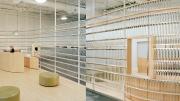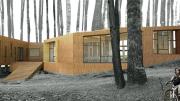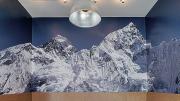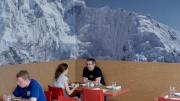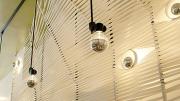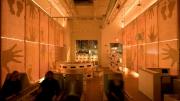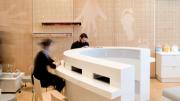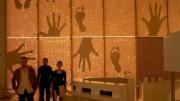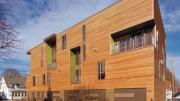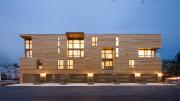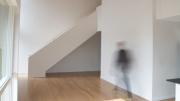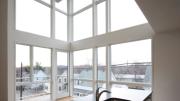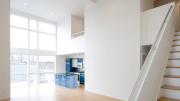In the summer of 1991, as a new North Carolina State University graduate in environmental design in architecture, Elizabeth Whittaker, M.Arch. ’99, wore a hard hat, pouring concrete over rebars at Arcosanti, a planned community in the Arizona desert designed by the celebrated architect Paolo Soleri. “It was a hippie-throwback place,” she recalls. “Living off the land in a progressive, communal atmosphere. A hilarious place.” Today, as principal of MERGE Architects, Inc. (www.mergearchitects.com) in Boston, Whittaker still dons a hard hat occasionally, but now she’s overseeing the pours, and the buildings under construction are her own designs.
The hard hat suggests the hands-on, intimate involvement with details of a project that Whittaker specializes in, a way of working that she calls “extreme collaboration.” It’s a modus operandi that took form in the early days of her firm, which she founded in 2003, when “we were flying by the seat of our pants, doing these small, quick, needs-to-be-built-in-three-weeks-for-10-dollars kind of projects,” she explains. “We would be inventing the construction details right in the shop or on site with the artists and craftsmen--the steel fabricators, woodworkers, structural engineers, concrete fabricators. Every architect collaborates; this is extreme only in that it is so immediate. We’re inventing it with the tradesmen. I’ve built a practice on learning from these people--it’s more inventive when there are more voices.”
At a health club in Woburn, Massachusetts, for example, MERGE worked closely with a structural engineer to construct an undulating interior wall by physically stacking up cylindrical Voss glass water bottles from Norway, creating a reinterpretation of the glass block wall. The clear bottles nicely embody the club’s mission of health and fitness.
For a small firm (there are three on staff), MERGE has designed and/or built a considerable number of structures in its eight years: 35 residential, 14 commercial, and four institutional projects. “We make things,” Whittaker declares. “We’re not a firm that works on a lot of design competitions.” MERGE has done plenty of local, smaller-scale, super-fast projects: for example, design and build a loft residence or restaurant interior in six to nine months from date of hire. “They’re fast-track projects because often the client is paying two mortgages, or the rent has kicked in,” Whittaker explains. “The budgets are crazy tight, so we have to invent on the fly, very quickly.”
That spurs creativity. For the Yak & Yeti Nepalese/Indian restaurant in Somerville, Massachusetts, for example, on a budget “smaller than zero,” MERGE made something out of nearly nothing. The owner hired them to draw up basic plans--“This guy didn’t come to us for high design,” says Whittaker, grinning--and had planned to hang framed pictures of Mount Everest and the Buddha on the walls. Instead, MERGE took one stunning Everest photograph, made it into wallpaper, and bled it across three walls. They bought nine bare-bulb light sockets for $1.50 each and had circular mounts custom made for them (about $150); these now light a dining room and represent the Nepalese notion of the “nine eyes of the Buddha.” Whittaker and her colleagues spent weeks on ladders installing a wall and ceiling made of thin, horizontal cotton straps stretched between and around upright poles; the project ended up a net loss for the firm, but “We enjoyed it,” she says. “The food is fantastic, the restaurant is doing extremely well, and the neighborhood loves the space.”
The designs typically have clear, clean lines: “I’m interested in abstraction,” says Whittaker, who worked for a year in Berlin, where the Bauhaus legacy lingers. “We have to get to the point quickly. We don’t do fussy trim.” For example, in Quincy, Massachusetts, the six-unit Penn Street Lofts--which have won three awards from the American Institute of Architects (AIA) and its affiliates--is a multifamily residential building of 1,100- to 1,600-square-foot lofts, built most economically for $100 per square foot. It replaced a moribund industrial facility in a neighborhood of one- and two-family homes. (“We felt this building could be a catalyst for real change in the neighborhood,” Whittaker says.) The exterior has a crisp, angular simplicity, softened by red cedar siding. Instead of an “anonymous façade of repetitive windows,” each loft has its own window pattern. “The unit, and the life within the unit, become more of a cinematic moment on the façade, and that therefore involves the street,” she explains. “It’s not the same as having a front stoop, but it’s the next-best thing.” Balconies, instead of projecting outward, are recessed into the units’ footprints: “You have a balcony stating that this is your unit, distinct from the others.”
Her creative solutions to problems of site, structure, budget, timeline, and function have won Whittaker invitations to lecture at Taliesin West in Arizona and to represent the United States in an AIA lecture series in Puerto Rico, alongside architects from France and Spain. Last year and this, as design critic in architecture, she has also taught a studio--the heart of the curriculum--at the Graduate School of Design. “I love teaching,” she says. “It keeps your mind fresh and helps you stay engaged in all aspects of the discipline. It’s beyond stimulating.”
In the classroom, Whittaker can also reconnect with the feeling she had when she took her first architecture course and found it “the most fascinating, hardest, and most challenging thing I had ever done.” Having painted and done graphic design, she felt that architecture opened a door to infinite possibility. “Architecture is everything: it’s sculpture, it’s graphics, it’s product design--done in three-dimensional experiential space,” she says. “Layered on top of that, you have the responsibility of making a building people actually want to inhabit. How could I give that up and just do one of those, when architecture asked me to do them all?”

